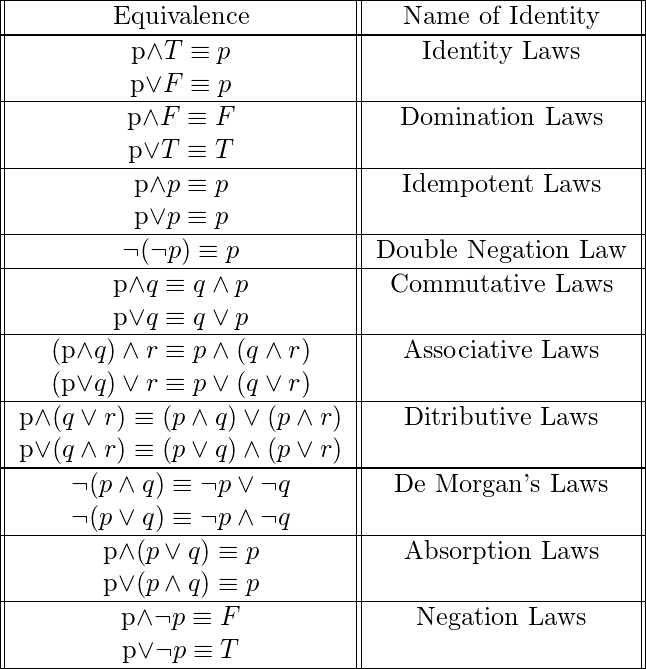Propositional Equivalences
Last Updated :
14 Sep, 2023
Introduction
Two logical expressions are said to be equivalent if they have the same truth value in all cases. Sometimes this fact helps in proving a mathematical result by replacing one expression with another equivalent expression, without changing the truth value of the original compound proposition.
Types of propositions based on Truth values
There are three types of propositions when classified according to their truth values
- Tautology – A proposition which is always true, is called a tautology.
- Contradiction – A proposition which is always false, is called a contradiction.
- Contingency – A proposition that is neither a tautology nor a contradiction is called a contingency.
Example,
1.  is a tautology.
2.
is a tautology.
2.  is a contradiction.
3.
is a contradiction.
3.  is a contingency.
is a contingency.
Definition of Logical Equivalence
Formally,
Two propositions

and

are said to be logically equivalent if

is a
Tautology. The notation

is used to denote that

and

are logically equivalent.
One way of proving that two propositions are logically equivalent is to use a truth table. The truth table must be identical for all combinations for the given propositions to be equivalent. But this method is not always feasible since the propositions can be increasingly complex both in the number of propositional variables used and size of the expression.
In this case, there needs to be a better way to prove that the two given propositions are logically equivalent. That better way is to construct a mathematical proof which uses already established logical equivalences to construct additional more useful logical equivalences.
Some basic established logical equivalences are tabulated below-

The above Logical Equivalences used only conjunction, disjunction and negation. Other logical Equivalences using conditionals and bi-conditionals are-

Example,
Show that

.
Considering LHS,

Another example,
Show that

.
Considering LHS,

The above examples could easily be solved using a truth table. But this can only be done for a proposition having a small number of propositional variables. When the number of variables grows the truth table method becomes impractical.
For a proposition having 20 variables,

rows have to be evaluated in the truth table. This may be easy to do with a computer, but even a computer would fail in computing the truth table of a proposition having 1000 variables.
GATE CS Corner Questions
Practicing the following questions will help you test your knowledge. All questions have been asked in GATE in previous years or in GATE Mock Tests. It is highly recommended that you practice them.
1.
GATE CS 2008, Question 33
2.
GATE CS 2014 Set-2, Question 63
3.
GATE CS 2006, Question 27
4.
GATE CS 2015 Set-3, Question 65
References,
Logical Equivalence – Wikipedia
Discrete Mathematics and its Applications, by Kenneth H Rosen
Share your thoughts in the comments
Please Login to comment...